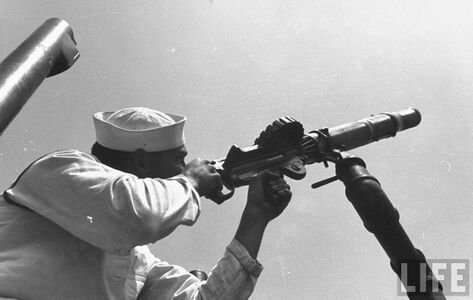Gun photos & information
Machine Guns
M1917 Lewis Machine Gun
-
Photo courtesy of the Life Magazine archives, a copy in the private collection of Ric Hedman.
-
Photo courtesy of the Australian War Memorial.
The M1917 Lewis light machine gun rose to prominence during WWI. It was a popular infantry weapon on the front in Europe and it also saw extensive use on aircraft. Despite being only .30-06 caliber, it had an imposing look due to the large heat-sink cooling tube that surround the main barrel. This tube had fins on the inside that helped to disperse heat while firing. The 47 round pan magazine sat atop the weapon and could be quickly changed. The Navy adopted the weapon during the war and it became the first machine gun to equip U.S. submarines. It was used as a self-defense weapon and in an anti-aircraft mode. It could be fired from the shoulder using the standard stock and bipod mount, or attached to a pintle mount topside (usually on the bridge). This photo shows the weapon being aimed from the bridge, using an optional vertical handle in place of the stock.
Although these guns were undoubtedly still in use through WWII (likely on the O & R-class training boats), they had been largely supplanted by the M1918 Browning Automatic Rifle and the M2 .50 caliber machine guns.

A color photo of the Lewis, with two open pan magazines on display. Although it was a little tedious to load the magazines with rounds, once loaded several magazines could be brought topside and quickly changed out by the gunner.
Some of the heat-sink fins can be seen just at the end of the large cooling tube, near the receiver.
Photo courtesy of Sturmgeweher.com.

A M1917 Lewis gun seen mounted above the trim manifold on the R-16 (SS-93) in 1923. This version has the standard stock installed.
Photo in the collection of the Vallejo Naval & Historical Museum. Contributed by Darryl Baker.
M1918 Browning Automatic Rifle

Use of this weapon onboard U.S. submarines continued in limited numbers into the 1960s, and the BAR saw service with the Army and Marine Corps well into the Vietnam war.
Photo courtesy of Historicalfirearms.com.
Automatic Cannons
20 mm Mk 5 and Mk 10
The first 20 mm mount to make it to the Submarine Force was the Mark 5, and it began to be fitted to submarines in early spring of 1942. The gun itself was made of corrosion resistant metals so that it could be left topside when the boat dived. At over 150 pound the gun was too hefty to manhandle down a hatch. The mount was characterized by a tall, solid, narrow cone base with a single gun. At 62 inches high it was so tall that a raised semi-circular stand usually had to be installed around the mount so that shorter gunners could use the weapon. The increase in firepower thrilled the submarine crews, and the weapon was used mostly to shoot up small sampans and fishing boats. By late 1942 the gun had become standard equipment for new construction boats, with most fleet submarines carrying two of the weapons.
Later in 1943 the Mk 10 mount began to replace the Mk 5. This mount used essentially the same gun, but had a new tripod style base that was considerably lighter in weight. It was also shorter, making it usable to nearly all gunners.
Both mounts were initially installed aboard submarines with two rectangular steel shields on either side of the gun. The intent was to provide the gunner with at least a modicum of protection during a gun action. Most submarine crews quickly dispensed with the shields as unnecessary, although pictures can be found both with and without the guards in place.
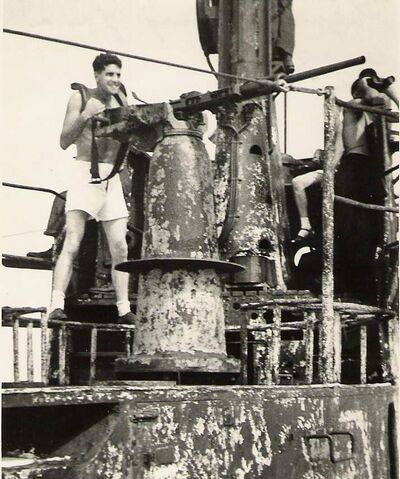
Pompano crewman Ralph Pleatman manning the boat's after 20 mm Mk 5 mount in 1943, located on the "cigarette deck" just aft of the bridge. Note the semi-circular platform he is standing on.
Photo courtesy of Rick Connole via Navsource.org.
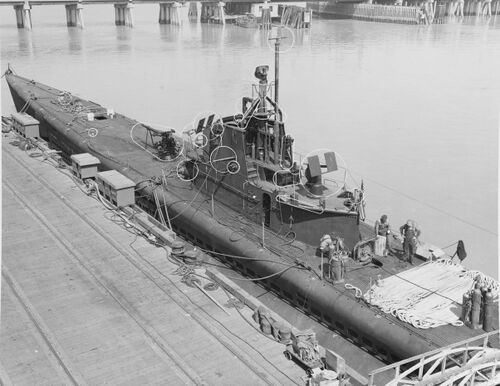
A 1943 photo of Salmon that shows her equipped with two of the Mk 5 mounts, both on the fairwater gun decks. The gun shields are installed on these brand new mounts, but the guns themselves have not as the boat was still in an overhaul at Mare Island. It was typical for the boats to dismount the 20 mm guns when stateside, as there was a minimal threat from enemy attack while inport in the U.S.
Photo 19-N-42439 courtesy of NARA and NHHC.
40 mm Mk 3
Deck Guns
3"/23 caliber Mk 9
The gun proved to be less than thrilling in its performance. It fired a small (13 lb.) shell that had only a .28 lb bursting charge. With the short 69 inch barrel the muzzle velocity was low. Combining these two factors resulted in a gun that lacked the hitting power to finish off even small targets quickly. It did not have any sort of central fire control and was used in line-of-sight mode only, thus limiting its accuracy from the pitching and rolling deck of a small submarine.
Reports were also received that the gun had the unnerving tendency to spontaneously retract into its tub without warning, especially with the recoil of firing. This obviously presented a dangerous safety hazard to the gun crew.
The gun was installed on most of the L-class boats, the M-1, the O-class, the San Francisco built units of the R-class (soon replaced with a 3"/50), and on the S-1. Its shortcomings had it removed from the L and O-classes after the end of WWI, and the installations on the R-boats and S-1 was short lived. By the late 1930s it was gone altogether.

This photo shows the gun raised and trained to starboard on the M-1. Note the very small amount of deck space to work the gun.
Photo in the private collection of Ric Hedman.
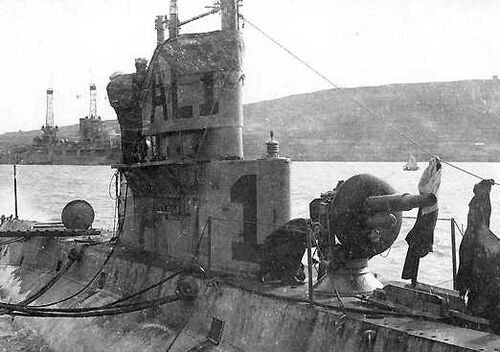
A view of the raised gun on L-1 from forward. The circular shield is clearly seen, with the recoil cylinder protruding below the barrel. This was the original version of the mount, with the cone shaped base. It was used on the L-class and the M-1.
Photo via Navsource.org.
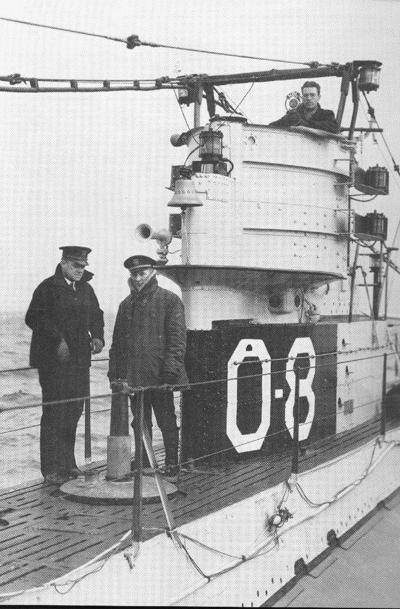
The gun shown retracted on the O-8, just in front of the two officers, early 1920s. In this mode the gun looked like a thick stanchion post. The gun tub penetrated the pressure hull in the forward battery compartment and used up a lot of space. This was another reason that the gun was disliked by the crews.
Photo in the private collection of Ric Hedman.

This photo shows the raised mount on the R-20, 1919. This is the revised mount that was used on the O and R-class submarines. It had clips on the side between the base and the gun that held ready service ammo, used until more rounds could be handed up from below.
Photo courtesy of the Vallejo Naval & Historical Museum in Vallejo, California via Darryl Baker.
3"/50 Mark 7 Mod 19
The gun became available during the construction of the R-class in 1918. Its characteristics so impressed the force that it was ordered to replace the 3"/23 Mark 9 that had been originally specified for those boats. Production delays caused the west coast built units of the R-class (R-15 to R-20) to get the original gun. The east coast units were built with an expanded deck sponson needed to operate this gun, but the guns themselves were not installed until after the boats were commissioned. R-15 to R-20 had the Mark 7 retrofitted during overhauls in 1919.
Seeking to discourage aggressive skippers from making surface gun attacks, the Navy's General Board dictated that the new fleet submarine of the Porpoise-class of 1934-1935 be equipped with this gun. Later overhauls had these boats upgunned with the more modern 3"/50 mounts, with some boats receiving the 4"/50 Mark 12.

The Mark 7 gun on the R-7. These boats could train the gun either forward or aft for transits. In this picture the forward bipod barrel lock is engaged. On the far left the square plate that the breech cover attached to is just visible.
Photo in the private collection of Ric Hedman.

R-17's Mk 7 gun shown trained aft. This gives a good view of the box-shaped breech cover. It would be removed and set aside as the gun crew swung the gun into action. It took just seconds to put it back in place.
National Archives photo.
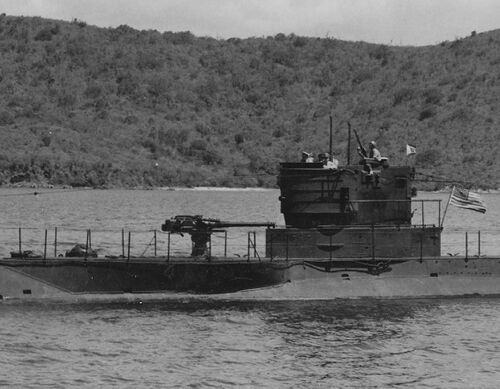
R-12's gun trained aft and secured to a barrel lock on the forward edge of the conning tower fairwater, circa 1942. It also appears as if the box-shaped breech cover is not installed in this photo. Note the M1917 Lewis gun mounted on top of the bridge aft of the periscopes.
National Archives photo 80-G-7252 via Sean Hert and Navsource.org.
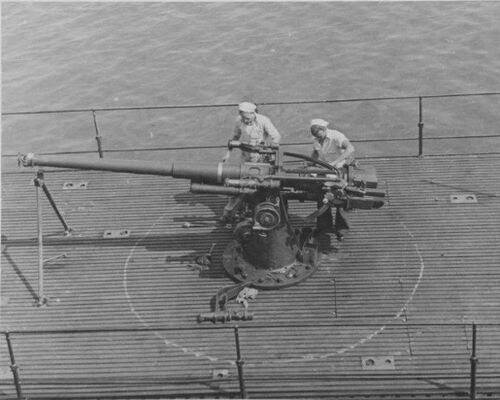
Two crewmen performing maintenance on Permit's Mark 7 gun, circa 1939. This is a good overhead view of the gun, and the installed breech cover is clearly seen on the right. One of the pointing scopes has been removed and is laying on the deck. The bipod barrel lock on the left folded down to the deck when not in use.
Photo courtesy of Tommy Trampp via Navsource.org.
Page created by:
Ric Hedman & David Johnston
1999 - 2023 - PigBoats.COM©
Mountlake Terrace, WA, Norfolk, VA
webmaster@pigboats.com

